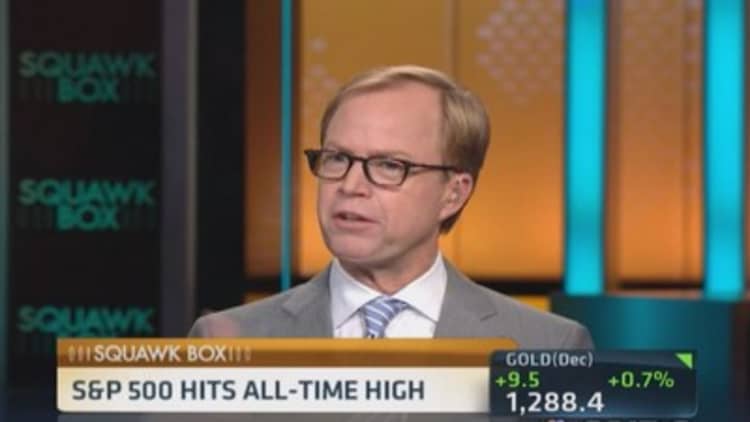The mix of stocks, bonds and cash you hold determines your level of risk and likely return. But it doesn't exist in a vacuum.
Over time, different asset classes produce different returns, causing your portfolio to drift from its target allocation.
Stocks, for example, typically outperform their fixed-income counterparts, causing a conservative portfolio that consists of, say, 60 percent equities and 40 percent bonds to gradually become more equity heavy, rendering the investor more vulnerable to market swings.
Thus, rebalancing is not only wise but critical to managing risk, said Paul Zemsky, chief investment officer of Voya Investment Management, noting a well-balanced portfolio is also less volatile, which helps investors stay the course.
Read MoreGet smart with Social Security
The ability to avoid knee-jerk reactions in the face of market turbulence has long been associated with higher returns.
"Every year, we see sectors that are winning for a year or two, but they always revert," said Zemsky, noting that real estate investment trusts, airlines, health-care facilities and semiconductors have posted the strongest gains so far in 2014.
"Sectors get frothy, people get overly optimistic, and expectations get built in that can't be met," he added. "You have to sell off the overweight, which should lead to better returns over time."
Data from fund tracker Morningstar suggest he's right. A portfolio with 60 percent exposure to the S&P 500 and the remaining 40 percent allocated to government bonds, it found, would have produced a nearly 15 percent total return between January 2004 and December 2013 if rebalanced annually. That same portfolio would have returned 7.5 percent if never rebalanced.
Read MoreLearn to respect risk
Simply put, rebalancing means selling off some of the gains from your better-performing assets and using those proceeds to buy more of your laggards.
But there's much to consider when bringing your asset mix back in line.

There are transaction costs, tax implications and investment objectives to factor in.
To rebalance effectively, you'll first need to decide how often and how much.
Read MoreThe pros, cons of tax-loss harvesting
Tinkering too frequently with your asset mix, after all, can be costly. The combination of trading fees, capital gains and administrative costs (if a professional investment manager is used) might diminish any benefit of reigning in portfolio drift.
Some financial planners recommend rebalancing at the end of each calendar year if your allocation has deviated even marginally. Others, such as Melissa Motz, certified financial planner and president of Motz Wealth Management, review clients' portfolios quarterly and hit the reset button only when their target mix is off by 10 percent or more. Much depends on the individual investor, however.
Risk control, cost minimization
For most broadly diversified stock and bond fund portfolios, annual or semiannual monitoring, with rebalancing when a target allocation drifts by 5 percent or more, is likely to produce a reasonable balance between risk control and cost minimization, according to Vanguard mutual fund firm.
The process of selling some of your better-performing stocks to purchase securities that have performed more poorly, however, can be a tough sell for some investors.
Read MoreDon't turn to alternatives: advisor
"What tends to happen is when the markets are going up, people want to be riskier and have a more aggressive allocation, and when things are going down, it's the opposite," said Motz, who reminds clients regularly of the long-term benefit of steady returns. "It's good to have a sell discipline as well as a buy discipline."
She added that "getting emotionally attached to a stock is never a good idea."
Many also delay rebalancing for fear of triggering capital gains. That's a mistake, said Zemsky at Voya.
"Tax implications should not drive your portfolio decisions," he said. "Perhaps you had carryover losses from a prior year, which can help offset the gain, but either way, the decision to buy and sell stocks should be based purely on investment rationale."
Read MoreIRS ups 401(k) plan limits
You may be able to maximize your after-tax return, however, by selling in blocks to spread your gains into several tax years to prevent you from jumping into a higher tax bracket, said Motz.
Likewise, you can defer your capital gains for longer by holding on to your best-performing stocks and using new money to restore portfolio balance instead.
Adaptability is key
In the quest to keep your tax bite minimal, asset "location"—or the position of your securities in taxable brokerage accounts vs. tax-deferred accounts, such as traditional IRAs and 401(k) plans—is also important. If you own the same investments in both types of accounts, you may be able to lessen your tax liability by selling shares in your tax-deferred account first, said Motz.
But don't restore your portfolio to its original allocation blindly. Consider life changes that may affect your investment strategy. Perhaps you started a business, decided to retire early (or late), became ill or inherited money you didn't expect. Or perhaps your view of the markets has simply changed. Your asset allocation needs to adapt.
Read MoreTarget-date funds a good downturn hedge
Whether done at year-end, quarterly or on your birthday—which some planners suggest—rebalancing is also an opportune time to assess your underlying investments and perform basic maintenance.
Keith Singer, certified financial planner and founder of Keith Singer Wealth Management, notes that 10-year Treasury yields have been so low and shorter-term bonds pay so little that he's moving clients into alternative securities for fixed-income exposure.
Before, you were tied up if you bought a modified endowment contract. But recently they have come out with a few that are completely liquid.Keith Singerfounder of Keith Singer Wealth Management
"We're using senior secured floating-rate funds, REITs that are less interest-rate sensitive, like office REITs, pipeline stocks, and insurance products called modified endowment contracts, with no interest-rate risk," he said. "Before, you were tied up if you bought a modified endowment contract.
"If you wanted your money out, you took a big hit," Singer added. "But recently they have come out with a few that are completely liquid."
Read More3 reasons to avoid ETFs
Portfolio rebalancing is the cornerstone of good investing. To meet your long-term goals, you must be prepared to monitor your asset allocation and sell off any gains that throw your target mix out of whack.
"Your asset allocation is done with a good amount of care to provide a certain risk-adjusted return," said Voya's Zemsky. "As the markets move differentially, you become overweight or underweight relative to your financial plan and you'll need to move back toward the plan."
—By Shelly Schwartz, special to CNBC.com




